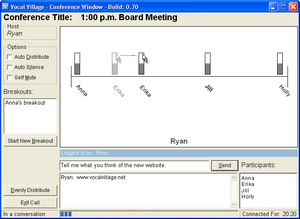Ever wondered how to identify different video formats or what to do to preserve old tapes. My colleague Liss Platt has helped author a useufl guide for the Texas Commission for the Arts, Video Conservation Guide. There is a great section on how to identify video format.
Category: Streaming Media
Vocal Village

Vocal Village is a project by Mark Chignell and company at the University of Toronto. I knew him when I was at U of T and he had just arrived. Now his team is doing neat work across the spectrum of multimedia and usability. Vocal village is an audio conferencing over IP solution that has some neat features like spatialization and a visual interface.
120 Years of Electronic Music

Electronic Musical Instruments: 1870 – 1990 is a clean site devoted to electronic instruments from the musical telegraph to the Optigan (don’t ask). For each instrument or company there is a page of history and images. Beauty, eh!
Podcasting: audio for your iPod
The Globe and Mail has a good story from the Associated Press on ‘Podcasting’ lets masses do radio shows (Matthew Fordahl, Monday, Feb. 7, 2005). The story gives some history and describes some of the uses of postcasting. For more see iPodder.org.
Less than a year old, podcasting enables anyone with a PC to become a broadcaster. It has the potential to do to the radio business what Web logs have done to print journalism. By bringing the cost of broadcasting to nearly nothing, it’s enabling more voices and messages to be heard than ever before.
TV Searching: Google, Yahoo and others
According to Information Week, Google Search > Google, Yahoo Jump Into Video Search Arena > January 25, 2005″ href=”http://www.informationweek.com/story/showArticle.jhtml?articleID=57703718″>Google, Yahoo Jump Into Video Search Arena, Antone Gonsalves, January 25, 2005. They are not the first to provide video search. Blinkx lets you search a variety of TV sources and then displays results with close caption text that matches your search and a small thumbnail video clip from the source.
It is amazing how powerful the text search engine paradigm is and how such engines can be applied to other media ñ in fact across media.
LoveStage Professional: QuickTime Authoring
Totally Hip Technologies Inc. has a QuickTime authoring environment that you can use to author video interactives. I came across this reading about David Wolf’s Vidget 1: an interactive networked VJ application for Quicktime (he is now up to version 3.5.) Other uses include streaming lecture interfaces. Uniquely able to work with video to create interactive interfaces in a way that Flash doesn’t really.
podSites: Simple hypertexts for the iPod
Audrey pointed me to a very neat idea and site, podSites.com. The site describes how to develop simple hypertexts or podSites for the iPod Notes area. The trick is that the iPod supports HTML links in the text file notes to other notes and links to audio that can play. The podSites site has instructions on how to create a podSite and “podCasting” (blogging for iPods) and so on. The site can be viewed in six basic colours – cute!
SquaredCircle: Flickr Shows as Conceptual Movies
Adrian Miles in a blog entry, The Beginning, points out how Flickr shows can be seen as conceptual movies. He proposes that we should agree on some theme and do a collaborative movie. See squaredcircle slideshow on Flickr for an example.
Dictionary Coding
Dr. Shirani is a colleague in Electrical and Computer Engineering. A Ph.D. student we are both second readers for drew my attention to course slides he put up that explain coding techniques for text and streaming. In particular the Dictionary Coding slides are interesting on LZ and LZW algorithms that are foundational (and really neat.)
What is the GRID?
What is the Grid? is a deceptively simple web site that combines streaming video clips answering questions around “What is the GRID?” The answers are short clips of experts in the field. The design effectively gives you a map of faces that have popup questions which launch the video windows. What they don’t allow me to do is run two clips at the same time (in dialogue).